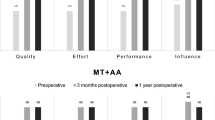Abstract
The present study was undertaken to assess the efficacy of medialization thyroplasty on outcome of voice quality in vocal cord paralysis by analyzing the voice. A total 19 patients with vocal cord paralysis of different etiologies were included in the study. Preoperative voice analysis was done by voice recordings, GRBAS score, maximum phonation time (MPT) and acoustic analysis using Dr Speech software (University version 4.0) using habitual fundamental frequency (F0), jitter %, shimmer % and normalized noise energy (NNE) as parameters. 18 patients underwent type 1 or medialization thyroplasty alone and 1 patient had undergone medialization thyroplasty along with arytenoids adduction. Post operative voice analysis was done using same parameters. There was post operative improvement of voice in 16 patients whereas 3 patients showed no significant improvement. Mean preoperative MPT was 4.8947 s and post operative was 13 s. Mean preoperative GRBAS score was 76.1579 and post operative was 30. On acoustic analysis, mean preoperative habitual fundamental frequency (F0), jitter %, shimmer % and NNE was 278.16 Hz, 1.7, 6.81 and 1.81 dB respectively whereas post operative mean was 132.37 Hz, 0.41, 1.65 and 123.38 dB respectively. Thyroplasty offers good voice outcome in patients of uncompensated vocal cord paralysis. Improvement can be documented in terms of perceptual evaluation of voice and acoustic analysis as well as maximum phonation time in addition to voice recording.
Similar content being viewed by others
References
Brunings W (1911) Uber eine neue Behandlungsmethode der Rekurrenslamung. Verh Verl Deutsch Laryngol 18:93
Payr A (1915) Plastik am Schildknorpel zur Behebung der Folgen einseitiger Stimmbandlahmung. Dtsch Med Wochenschr 41:1265
Isshiki N, Okamura H, Ishikawa T (1975) Thyroplasty type I (lateral compression) for dysphonia due to vocal cord paralysis or atrophy. Acta Otolaryngol 80:465
Isshiki N, Morita H, Okamura H, Hiramoto M (1974) Thyroplasty as a new phonosurgical technique. Acta Otolaryngol (Stockh) 78:451–457
Friedrich G, de Jong, Mahieu HF, Benninger MS, Isshiki N (2001) Laryngeal framework surgery: a proposal for classification and nomenclature by the Phonosurgery Committee of the European Laryngological Society. Eur Arch Otorhinolaryngol 258:389–396
Koufman JA (1989) Surgical correction of dysphonia due to bowing of the vocal cords. Ann Otol Rhinol Laryngol 98:41
Blaugrund SM, Taira T, El-Assuooty A, Lin PT, Isshiki N, Gould WJ (1990) Effects of lateral manual compression upon glottic incompetence: objective evaluations. Ann Otol Rhinol Laryngol 99(4 Pt 1):249–255
Lundy DS, Casiano RR, Xue JN (2004) Can maximum phonation time predict voice outcome after thyroplasty type 1 114(8): 1447–57
Speyer R, Bogaardt HC, Passos VL, Roodenburg NP, Zumach A (2010) Maximum phonation time: variability and reliability. J Voice 24(3):281–284
Wendler J, Rauhut A, Kruger H (1986) Classification of voice qualities. J Phonetics 14:483–488
Morsomme D, Jamart J, Wery C, Giovanni A, Remacle M (2001) Comparison between the GIRBAS Scale and the acoustic and aerodynamic measures provided by EVA for the assessment of dysphonia following unilateral vocal fold paralysis. Folia Phoniatr Logop 53(6):317–325
Zhang Y, Jiang JJ, Biazzo L, Jorgensen M (2005) Perturbation and nonlinear dynamic analyses of voices from patients with unilateral laryngeal paralysis. J Voice 19(4):519–528
Plant RL, Hillel AD, Waugh PF (1997) Analysis of voice changes after thyroplasty using linear predictive coding. Laryngoscope 107(6):703–709
Shin JE, Nam SY, Yoo SJ, Kim SY (2002) Analysis of voice and quantitative measurement of glottal gap after thyroplasty type I in the treatment of unilateral vocal paralysis. J Voice 16(1):136–142
LaBlance GR, Maves MD (1992) Acoustic characteristics of post-thyroplasty patients. Otolaryngol Head Neck Surg 107(4):558–563
Gray SD, Barkmeier J, Jones D, Titze I, Druker D (1992) Vocal evaluation of thyroplastic surgery in the treatment of unilateral vocal fold paralysis. Laryngoscope 102(4):415–421
Author information
Authors and Affiliations
Corresponding author
Rights and permissions
About this article
Cite this article
Chowdhury, K., Saha, S., Saha, V.P. et al. Pre and Post Operative Voice Analysis After Medialization Thyroplasty in Cases of Unilateral Vocal Fold Paralysis. Indian J Otolaryngol Head Neck Surg 65, 354–357 (2013). https://doi.org/10.1007/s12070-013-0649-3
Received:
Accepted:
Published:
Issue Date:
DOI: https://doi.org/10.1007/s12070-013-0649-3




